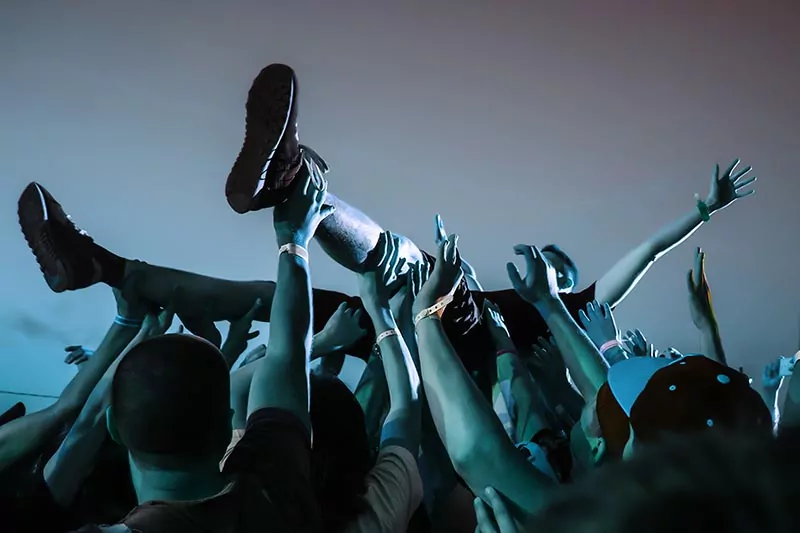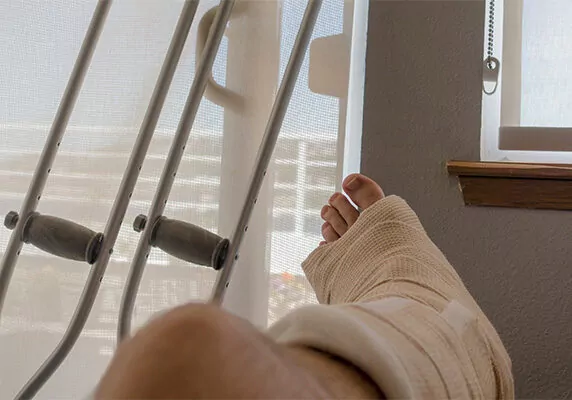Sonny Moore, better known as Skrillex, a world-renowned concert DJ and producer, was ordered in November 2018 to pay damages for a concert injury occurring at a 2012 performance. The plaintiff alleged that Skrillex landed on top of her during a stage diving stunt, causing an injury that led to a stroke sixteen days later.
Six years after the concert, and four years after the case was first filed, a Los Angeles jury sided with the fan, awarding her $4.5 million in damages.
The Skrillex stage dive payout is a classic example of a concert injury lawsuit, and a reminder of the dangers present at these events. Even with the best of intentions and an attentive venue staff, accidents do happen, and people get hurt.
Large concerts present a wide range of risk factors to attendees, requiring extensive preparation on the part of venues.
Large concerts, whether at open-air venues or stadiums, require an extensive amount of planning. The safety of everyone at an event, from the performers and their support crews to the fans themselves is the greatest concern. And while most concerts do proceed without incident, accidents are hardly uncommon. They can be the result of overlooked safety procedures, defective equipment, and even dangerous acts by the artists themselves.
Equipment failures can result in dozens of injuries at a packed concert venue.
Large concerts can involve tens of thousands of people. The technical accommodations for these concerts often utilize temporary construction or additions to existing structures. It is critical that these additions to a venue are built strictly to safety codes, as failing to do so may result in serious consequences.
An example of such a failure occurred at a 1994 Pink Floyd concert, which ended prematurely after a 1,200-seat stand collapsed, injuring 90 people. Two years later, multiple guilty pleas were filed by those held liable in the accident for breaches of the UK’s Health and Safety at Work Act.
Failures of load-bearing scaffolding and seating are among the most common, and dramatic, causes of concert injuries. However, electrical systems are another major concern at concert venues. A barefoot fan attending a 2003 concert in North Carolina died after they walked onto an electrically conductive wet concrete stairwell.

Some concert performers engage in unsafe acts that place fans in harm’s way.
In a 2011 performance, the singer for the All-American Rejects threw cans of an energy drink into the crowd. One fan was struck on the head, causing an injury that required 12 stitches.
In a crowd surfing stunt gone wrong, DJ Steve Aoki was sued in 2016 after a dangerous 20-foot stage dive onto a rubber raft being held up by the audience broke one attendee’s neck. The case was eventually settled out of court for an undisclosed sum.
Performers injuring their fans, whether through deliberate action or accident, is nothing new. Being hit by an object or a stage-diving DJ might be considered by frequent concertgoers as chance events that are part of the overall experience. However, the actions of some performers often go too far, and have significant consequences.
Sometimes attendees themselves are a source of concert injuries, especially when in a panic.
Any situation involving thousands of people in a concert space has some inherent dangers. Mosh pits are a commonly cited example of how a fellow fan can be as much of a threat to health and safety as a performer or shoddy equipment, though they’re often considered part of the experience. But a large crowd in a panic can quickly lead to a life-or-death situation.
In October 2018, a Central Park performance by Cardi B was punctuated by a loud, gunshot-like sound. Concert organizers and police commanders quickly determined that no shots had been fired. Staff came on stage to explain that the sound had been caused by the collapse of a fence, but panic had already ensued. People tried to flee through any available exit, trampling other concertgoers as they ran. The panic was further intensified as attendees stepped on discarded water bottles, adding more ‘gunshot’ reports to the cacophony.
Performers can also incite crowds to act in dangerous ways. Rapper Travis Scott was sued in 2017 by one concert attendee who was pushed off the third floor balcony of a sold-out Manhattan venue. Scott was recorded on stage encouraging fans to jump from the balconies to the first floor, stating that other fans would catch them. He was arrested earlier that same year for inciting a riot at another concert in Arkansas.
The question of who is ultimately liable for a concert injury is rarely straightforward, and many such lawsuits involve multiple parties.
Large concerts are the product of organizers, technical crews, performers, and security staff all working together to ensure the event proceeds as smoothly as possible. Because of this, when a major accident occurs, investigations can take a long time to uncover who was negligent, and how that negligence led to injury.
The Skrillex lawsuit resulted in $4.6 million in damages awarded to the injured concertgoer. However, the DJ wasn’t the only person involved with the concert. The lawsuit also named the venue and his touring company as liable parties.
For concert injury lawsuits, juries use the available evidence and testimony to determine who was at fault, and the extent of their contribution to the injuries suffered. In this case, the jury found that Skrillex himself was 35% responsible for the injury, and $1.6 million of the total damages. His touring company was 40% liable, and was ordered to pay $1.8 million. The venue itself was named 10% liable for its alleged failures to control the situation. However, the actions of a victim are also considered in these lawsuits. The jury stated that the plaintiff herself was 15% liable for the accident.
It can take years before such a case reaches a conclusion, and the question of liability can become muddled. Some parties can be let entirely off the hook if evidence points to specific individual acts of negligence. Alternatively, factors outside of human control, such as the weather, can also influence the result of a concert lawsuit.
If you do get injured at a concert, there are some things you can do in order to prepare for a lawsuit.
- Take notes of what or whom injured you: Concerts can be very chaotic, and in the moment of an accident, it can be difficult to sit down and assess everything that has just happened. But as soon as you can, try to write down what caused your injury and everything else you can remember about the accident.
- Find out as much as you can about who is responsible for hosting and operating the event: Research who owns the venue, those responsible for security and staffing, and so on.
- Find witnesses, or camera footage of the accident: A silver lining for any concert injury is that you are surrounded by witnesses and cameras. You might not be able to remember every detail about the accident, but others might have had a better angle on the situation. Additionally, many concert venues have security cameras, or may even have drone footage of the incident. All of this can be used as evidence.
- If you were using your own camera during the accident, back up the footage: A phone camera recording might catch something you didn’t see in the moments before your injury, and provide valuable context for the events that followed.
- Keep track of your expenses after an injury: Your injuries could result in medical or financial complications, and a fair settlement might be the only way you can pay off debts accrued during your recovery. For concert injury lawsuits, a detailed record of these expenses is especially critical, because of our last point.
- Be prepared for a very long case: The Skrillex lawsuit was filed two years after the incident, and it took four more years before a verdict was reached. Some cases might end in a settlement sooner, but in others, the performer or venue operator may fight vigorously against your claims. Scrupulous documentation ensures that when a verdict is finally reached, you will be fairly and fully compensated.
This blog is not meant to dispense legal advice and is not a comprehensive review of the facts, the law, this topic or cases related to the topic.



